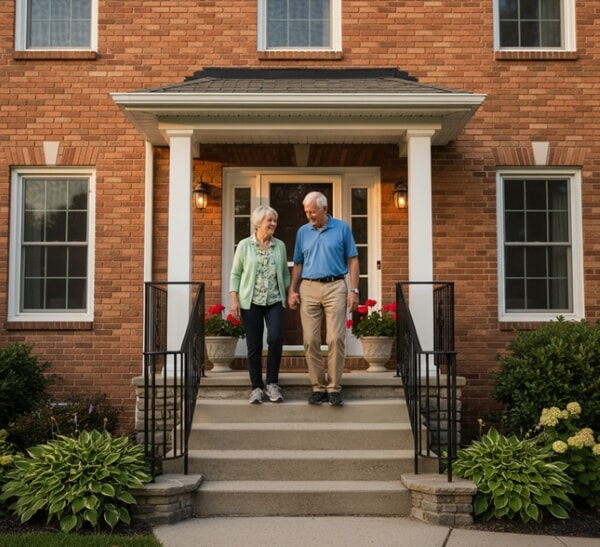Life-Saving Railings: Home Safety for Older Adults

You want to stay in your home as you age so you can remain comfortable, confident, and independent. However, your balance and mobility change over time, and everyday spaces can turn risky. The increased risk of falls is a major concern, as falls are the leading cause of injury among adults 65 and older, and more than 1 in 4 older adults reports a fall each year.
Those injuries are costly in every sense. U.S. medical spending related to older-adult falls is estimated at about $50 billion annually, much of it paid by Medicare and Medicaid. However, this doesn't account for the cost of long-term care, which is often the end result of a fall, and those ongoing costs are substantial, according to the LTC News survey of long-term care costs nationwide.
The Case for Railings and Grab Bars
Adding sturdy, well-placed handholds is one of the simplest ways to prevent injuries at home. Railings and grab bars help you maintain balance, rise and sit with control, and move without fear. That confidence encourages daily activity, which supports strength and overall health. Research also links better mobility with a higher quality of life in older adults.
Experts say that a well-placed grab bar can make the difference between a close call and a broken hip. It’s a small upgrade that can provide peace of mind and safety so you can remain at home as you age.
Where to Install First
Focus on the highest-risk areas and make smart, permanent fixes.
- Stairs (indoor and outdoor): Install secure railings on both sides. Extend rails beyond the top and bottom steps for safer transitions.
- Bathrooms: Place grab bars near the toilet and on both the inside and outside of the tub or shower. Use non-skid surfaces and night lights.
- Entrances and hallways: Add continuous handholds and make sure lighting is bright and switches are easy to reach. The CDC’s “Check for Safety” home checklist is a practical walk-through.
Style Without the “Institutional” Look
Safety can look good. Today’s products span modern to traditional:
- Finishes: Brushed stainless, matte black, bronze, or color-matched powder coat.
- Profiles: Rounded rails for a secure grip; textured options for wet areas.
- Integrated pieces: Grab bars that double as towel bars or shelves—function without visual clutter.
Think of railings the way you think of lighting, essential infrastructure that also shapes how your home feels. Professionals such as handrail specialists design systems that combine safety and aesthetics. These experts understand that each installation must meet both functional and visual standards, ensuring that every railing not only prevents accidents but also enhances the space it occupies.
Why Metal Often Wins
For longevity and low maintenance, metal railings have clear advantages:
- Resist moisture and corrosion—ideal for bathrooms and entries.
- Won’t crack, warp, or splinter like older wood rails can.
- Allow precise, code-compliant shapes and secure anchoring points.
- Broad finish options to match your décor.
Professional installation matters. Rails must be anchored into studs or with proper fasteners rated for the substrate and load.
Independence, Confidence, and Prevention
A single fall can lead to hospitalization, rehab, or a move to assisted living. In 2021, emergency departments recorded nearly 3 million visits for falls among older adults, underscoring the scale of the problem.
Practical upgrades like railings, grab bars, and better lighting will reduce risk and help you keep doing daily tasks on your own terms.
What it Costs vs. What it Saves
You could ignore aging and long-term care, but you ignore the real risk of falls in your home as you age. The high cost of in-home caregivers or, if required, a long-term care facility can drain even large savings accounts.
Compared with the cost of long-term care after a serious fall, railings and grab bars are inexpensive and durable. To understand the broader financial stakes in your location if an injury leads to extended care, check the LTC News Cost of Care Calculator.
Plus, if you have Long-Term Care Insurance, you have the guaranteed tax-free funds to pay for the quality extended care you will need, including at home.
- Understand the benefits of Long-Term Care Insurance with the LTC News Education Center.
If you need help finding licensed home care providers or senior living options, search the LTC News Caregiver Directory.
Action Checklist: Make Your Home Safer This Week
- Walk your home with the CDC’s free “Check for Safety” guide.
- Prioritize: stairs, bathrooms, entries, and long hallways.
- Choose grab bars with textured grips and ADA-appropriate diameters.
- Hire a qualified installer; avoid suction-cup bars for primary support.
- Re-assess lighting, throw rugs, thresholds, and clutter.
- Recheck annually—or after any change in health, vision, or medications.
- Review your Long-Term Care Insurance policy. If you don't have a policy, get LTC Insurance quotes and apply, ideally before you retire.
Think about: Which staircase, bathroom, or hallway could you make safer today for you or a loved one, and how much peace of mind would that buy you tomorrow?
Disclaimer: This article is for information only and is not medical, safety, or construction advice. Consult your healthcare provider, an occupational therapist, a licensed contractor, and a Long-Term Care Insurance specialist for individualized recommendations.


